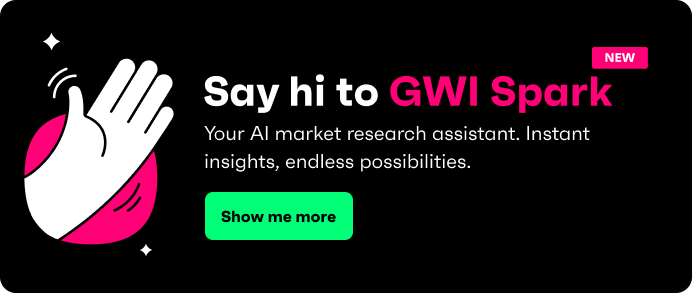
It’s time to get real. If you have a team of marketers worrying that AI is going to replace their jobs, we’re here to deliver the good news. AI’s here to help your marketers do better, faster work, alongside them, not against them.
From optimizations on the go, to content creation anywhere, any time, AI is clearing the "business as usual" work and sharpening the strategy. Whether you're scaling a global brand or launching a local campaign, this guide breaks down what AI can really do, how teams are using it, and what it means for your marketing today (and tomorrow).
Ready to cut through the hype? Let’s go.
The state of AI In digital marketing
When it comes to speed, performance, and relevance in digital marketing, AI is rewriting the playbook. It’s not just about automation - it’s about elevating every stage of the funnel.
For advertisers, it means real-time optimization. For brands, hyper-personalization at scale. For decision-makers, it’s a strategic shift from guesswork to data-driven precision.
Speed, scale, and insight are driving adoption. And the platforms at the forefront of this technology, like Meta, Google, and Adobe, are already baking AI into the core of their tools.
So where’s AI showing up in the day-to-day?
- Content generation: AI is using prompts to automate copywriting, visuals, and video.
- Personalization: It can offer dynamic product recommendations and tailored messaging.
- Consumer insights: Using AI, orgs are seeing faster segmentation, and smarter analysis. Tools with powerful, baked in tech like GWI Spark are helping marketers cut through the noise here by generating fresh, on-demand consumer insights in seconds, powered by real human data.
What does AI unlock for digital marketing teams?
Marketing teams have always had to juggle speed, scale, and personalization, but rarely all three at once. AI makes this possible. Hurrah!
It speeds up campaign creation, from testing creative variations to launching assets in-market. It sharpens targeting with real-time customer segmentation, so you’re reaching the right people at the right time. It brings better forecasting into play too, using predictive analytics to guide planning and uncover trends before they even happen.
Tools like GWI Spark take this further, by helping spot shifts in consumer behavior in real time, so your teams can act fast and stay ahead.
And most importantly - all marketers rejoice - AI can help you deliver personalization at scale. Relevant content, tailored journeys, and dynamic messaging are all within reach, without adding hours to the workload.
In short: AI takes the manual work off your plate so your team can focus on strategy, not spreadsheets. What’s not to love?
Popular AI marketing tools and use cases
There’s no shortage of tools promising this AI-powered magic. But which are actually driving results?
Let’s start with something we’re personally using the most in our teams: GWI Spark. It’s an AI assistant that uses generative AI to pull actionable consumer insights from GWI’s rich pool of global survey data, instantly. You don’t need to be a research pro or data expert. Just ask a question in everyday language, and get quick insights at your fingertips. Marketers who need speed and certainty when making decisions are winning by adding this product to their tech stack.
Many teams are already tapping into generative AI for content. Tools like ChatGPT, Midjourney, and Runway help create everything from headlines to hero images and full-blown videos. When it comes to SEO, platforms like Clearscope and Surfer are helping marketers plan and optimize content strategies with AI-driven analysis of SERPs, keywords, and content gaps, making life much easier.
Conversational AI is having a moment, too. With smarter chatbots and voice assistants that actually help users (not just frustrate them), the load on customer service is lightened.
On the media side, AI is powering automated bidding, creative testing, and precision targeting across ad platforms like Google and Meta, helping campaigns perform better without constant manual tweaks.
And it’s not just theory. Brands like Nestlé, L’Oréal, and Coca-Cola are already putting AI to work, creating faster, optimizing smarter, and connecting with audiences in a relevant, timely way.
Challenges and ethical considerations of AI in digital marketing
But let’s be practical. With AI, it’s not all upside. The benefits are big, but the risks can be too.
One of the biggest concerns is bias. AI is only as good as the data it’s trained on which means if that data carries bias, the outputs will too. That can lead to skewed targeting, poor personalization, and even reputational damage. The tool you use needs to work in the right way for your specific use case, so don’t just blindly trust the results. You need to keep a keen eye on what you’re getting back and do your research on where the results are being pulled from.
Then there’s the question of disclosure. Should your audience know when content is AI-generated? Transparency builds trust, but right now, standards vary across industries and regions. It’s very important to be aware of where your industry sits on this, and make sure you’re compliant.
Brand safety is another big one. AI hallucinations, misinformation, and off-brand copy can quickly derail a campaign. Your audiences are smart, and most will be able spot the tell-tale signs of lazy AI use. With regulation still evolving - from the EU AI Act to new FTC guidance, marketers need to keep one eye on the legal landscape as they scale their use of AI.
So here’s the bottom line: being responsible with AI is just as important as being innovative. The smartest teams are building trust into their systems from the start.
The future of marketing: What’s next with AI?
As we mentioned earlier on, AI’s next chapter isn’t about replacing marketers, but rather working with them. We’re moving into a phase of co-creation, where humans and machines combine forces to build smarter, faster, and more personalized experiences.
Think of it like this: AI handles the heavy lifting, swiftly surfacing insights, generating assets, and automating tasks. Marketers steer the vision, shaping the strategy, guiding the tone, and making the judgment calls.
This opens the door to predictive personalization, where messaging and experiences are tailored before someone even clicks. It also means the rise of autonomous campaigns: self-optimizing systems that adjust in real time, no pause button needed.
It’s a shift from reactive marketing to proactive orchestration, and it's happening right now.
AI maturity models for marketing teams
Not every team is AI-first, and that’s not a problem. What matters is knowing your starting point and building from there.
Most marketing orgs move through three stages of AI maturity:
- Pilot: Testing tools in small, isolated campaigns.
- Partial integration: Layering AI into selected workflows or departments.
- Full integration: Embedding AI across strategy, operations, and execution.
Understanding where you’re placed on that spectrum is the first step. A maturity matrix can help benchmark capabilities, identify gaps, and guide the rollout of AI in a way that actually sticks.
It’s not a tech upgrade you’re after, but a real, meaningful shift in mindset across the whole organization.
How to vet and choose the right AI tools
The AI tool market is crowded and moving at a breakneck pace. Choosing the right one for your teams shouldn’t feel like a shot in the dark.
Start by asking the basics:
- Do you need to build or buy? Custom tools offer control, but off-the-shelf solutions can get you moving faster.
- Will it integrate with your stack? Look for smooth alignment with your CRM, CDP, ad platforms, and analytics tools.
- Is it transparent? You should understand how the AI works, and where the data goes.
- Can it scale and stay compliant? Make sure it fits your ambitions and your legal responsibilities.
The best tools don’t just solve today’s problems. They’re built to grow with you, unlocking more value as your team’s AI maturity increases.
Training and upskilling teams for AI adoption
Long story short, marketers who know how to use AI will definitely have the edge over those not adopting it.
That’s why forward-thinking brands are getting proactive about training. Roles are evolving fast, especially for strategists, analysts, and media buyers. The skills in demand? Data literacy, ethical AI knowledge, and yes, prompt writing is quickly becoming its own craft.
In-house upskilling is also on the rise, from internal bootcamps to hands-on workshops that help teams build confidence and fluency with the tools they’re using every day.
The goal isn’t to turn everyone into a data scientist. It’s to make AI feel like second nature, not something to be feared.
Industry-specific use cases
AI looks a little different in every sector but the impact is equally transformative.
In retail, AI is providing everything from virtual stylists to dynamic pricing models and smarter inventory forecasting. Customers get more relevant shopping experiences, and brands get tighter margins.
In finance, AI is helping automate customer service, detect fraud, and model risk faster and with more accuracy than ever.
FMCG brands are using generative AI to design packaging, predict trends, and speed up innovation pipelines, often based on real-time consumer signals.
And in entertainment and media, AI is personalizing recommendations, generating trailers, and curating content so audiences get what they want, before they even know it.
The common thread? Faster insights, sharper execution, and a better experience for the end user.
Business value
The real value of AI for your business? Speed, efficiency, and strategic clarity.
Advertisers are optimizing campaigns in real time and reducing acquisition costs. Brands are streamlining content production while delivering more relevant, personalised experiences at scale. And decision-makers? They’re using AI to bring better alignment across teams, tools, and long-term strategy.
AI isn’t just another tool in the stack, it’s the catalyst for smarter, faster, more measurable marketing.
Want to see how GWI Spark puts that into action? Start generating instant consumer insights today, no data crunching required.





.webp?width=495&height=317&name=pink_thumb_graphs%20(1).webp)
.webp?width=495&height=317&name=pink_thumb_letter%20(2).webp)